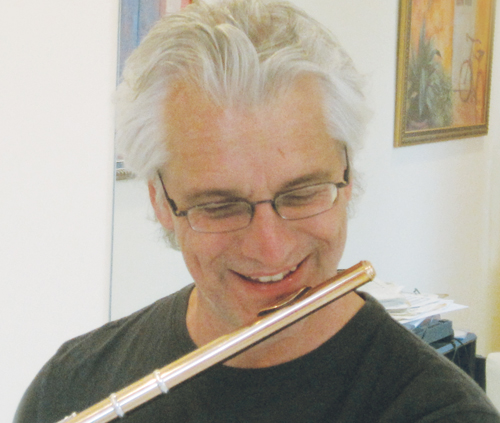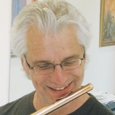
"Maybe you think you are using a lot of vibrato, but frankly I don’t hear it."
My teacher made this comment after I had been resisting his suggestion to use more vibrato in general. Not only was I unsure how to do it, but using more vibrato sounded exaggerated to me when I played. “Let’s do an experiment,” he continued. “I brought in the recorder today. You play the piece the way you are used to playing it first, and then try it with more vibrato, and we will listen to it and compare.”
Rather reluctantly I tried. “This is just a stylistic disagreement, it will pass,” I thought, but hearing the playback, I was surprised to learn he was absolutely correct. What I had heard for several years as a lovely vibrato in my sound was actually non-existent on the recorder.
I felt a bit embarrassed by my resistance to his previous suggestions, but that was just part of it. There were many things on the recording I was not aware of, and that I did not really like. I said to him, “I did not know I sounded so different to others. I will definitely use more vibrato in the future!”
My teacher, Robert Willoughby, was particularly perceptive, and in my case, particularly patient. He had thought about it and come to the conclusion that I was young, arrogant, and resistant to change, but more interestingly, also just ignorant. He surmised that I was too used to hearing the sound of my own playing from my perspective and was not aware how I sounded to others.
Practice Habits
With long hours of practice come ingrained habits of preparation, and listening. Over time, we assume that some methods will result in the fastest improvement, and that we sound a certain way. In cases of the particularly arrogant, such as my 18-year-old self, sometimes these assumptions can harden into absolute belief. These beliefs can be harmful to progress unless some degree of objectivity can be attained and habits are questioned regularly.
Differences in perception can also cause confusion. You may think you understand what a teacher is recommending, but things can get lost in translation. Your version of what the instructor is teaching may be, in practice, quite different than his. With the teacher’s permission, it can be helpful to record lessons. Usually things do improve with repetition and patience over a long time, but it can be hard to determine for ourselves whether we are wasting time and effort, and whether the process is really working. Teachers may not frequently go into detail about practice methods, focusing on results and time spent practicing instead of examining the preparation process with students.
For much of the time students are left to their own devices, with a trial and error approach. If they understand the information from lessons, this can actually be the best way. What is discovered by one’s own method is often learned most effectively. According to John Krell, author of Kincaidiana, the great flutist and teacher William Kincaid did not go into elaborate detail about embouchure and sound; instead he inspired students to search for their own tone. Other teachers are more formulaic and assume that their own methods will work best for students.
The work must be done, the notes must be learned, and a good technique is a prerequisite for artistry, but bad habits can become standard practice if care is not taken to listen attentively while playing. If a student has a teacher who demands much material every week, a numbness can set in, and some areas can become neglected regularly. Kincaid’s approach places the burden of responsibility ultimately on the student’s shoulders. Teachers cannot be babysitters. At the end of the day musicians must learn the way they sound and work with it. Take responsibility and become as familiar as possible with your habits and assumptions, and decide if they are truly what you want.
Sound Deception
Flutists get used to their sound, which is based upon embouchure, physical traits, and position. It is common to work with long tones to achieve better clarity and resonance. At the end of a session, the results may be marginally acceptable, but problems have basically gone unchallenged. Many times students feel they should move on to other material and assume that if the tone feels the same as usual, all is well and their duty is done for the day. Students often do not hear or notice how they truly sound. (Teachers can demonstrate this by placing their hands in front of students’ ears to provide a better sense of the sound. This can be very revealing, and not necessarily pleasant.)
The practice space also affects how clearly flutists can hear their tone when practicing. Steven Finley, President of Haynes Flute Company, once told me that the esteemed teacher Britten Johnson suggested he practice in his apartment’s clothing closet for a month after Steven complained that his tone sounded airy. Apparently it helped. Like Mr. Finley, at some point we must face the music, drop the self-deception, and be willing to question everything in order to get to the next level.
Raising Awareness
The artistic journey could be summarized as a voyage toward discovering one’s own truth. It is truly difficult to become aware of what you are actually doing with the music. The truth can hurt so we avoid discovering it. It is often easier to just turn on the auto-pilot when practicing. I once heard James Galway refer to this as wasting time. “Do not waste your life, it is too precious!” he said. Eventually it all comes back to us. Our ignorance is definitely not bliss for the audience. Sometimes students grow so used to their mistakes that they are unaware of them and repeat them for years.
In reality it is quite impossible to hear what you sound like to others. Everyone will have their own interpretation of a sound, but a recording makes it possible to more approximately understand what others hear. Like the hands in front of the ears exercise or discovering at the end of a meeting that your fly is open, it can be a rude awakening to hear what you sound like to others. Everyone has experienced this upon hearing a playback of their voice.
When reviewing a recital recording, it can seem as if the sound files were mixed up. Surely someone has pressed the wrong button. Poor intonation, rushed rhythms, and vibrato that cannot be heard in the top notes, all seemed fine when heard as you played. Maybe it would not be such a shock if flutists recorded themselves on a daily basis.
Tools
Ironically, it has never been more convenient to hear oneself play. From phones with audio and video capability to metronomes that spit out compound rhythms, Music Minus One, lessons from remote locations, and orchestral training programs, flutists of the past could scarcely imagine the tools at our disposal today. In Krell’s Kincaidiana no mention is made of a home recording device for practice, because recording in those days was so cumbersome, inaccurate and unavailable.
Making the Leap
Professional players often use a recorder regularly as part of their preparation, but many advanced students still seem in the dark about the details of their own sound and the process of using a practice recorder. The pros have made a leap somewhere and confronted the challenges and barriers to using a recording device regularly and effectively.
Procrastination
Perhaps students feel that with time constraints, learning notes and practicing scales should have primary importance. It is easy to decide to work on sound and phrasing later when there are so many notes to learn. Work then proceeds without regard for the tone. This is particularly harmful, as they can get accustomed to hearing a poorly supported and unfocused tone. Also, technique is closely related to tone production. The notes must be learned, but a recorder confirms that you have stayed on course with good sound and proper phrase grouping.
The Dreaded Microphone
Do not place the microphone too close to the flute. Because of the nature of the instrument there will always be some extra playing noise as the air column vibrates over the blowing edge. While it is good to try to minimize this effect, enhancing the noise with a microphone can lead to closing, producing a smaller tone. With the microphone too close, distortion at loud dynamics is also a problem. Putting the microphone too far away can mask the reality of tone, giving an overly positive impression. Place the microphone a moderate distance away to get a balanced sound picture. Remember that the practice space is important; again, modify acoustics for balance: not too dead, but not too resonant.
Confusion
Listening to a playback sends too many messages to process all at once, and there is the emotional element also. The most important part of listening to yourself is organization. Be objective and concentrate on improving one aspect at a time. For example, play a phrase of the piece, first working on tonal focus. Are all the notes resonating? Then study the rhythm. This is especially important when practicing orchestral excerpts. After mastering the rhythm, move on to other areas such as vibrato and intonation, addressing each separately.
Lack of Guidance and Example
If you have never listened to a playback with a teacher, take some to a lesson for feedback. It could be that you are hearing and doing things a bit differently. Learn how your teacher uses recordings as a tool for progress, and then develop your own approach.
Time Pressure
One reason students avoid taping themselves is that it seems like recording and critiquing playback in small segments will take forever. This is actually not true. A good one-hour session with a recorder can erase years of self-deception. The amount of time taken to hear, acknowledge, and correct a single rhythmic error after hearing it on the recorder pales when compared to years of making the same mistake and not realizing it.
Fear
Recording yourself and listening to playback is hard on the self-esteem. Only after time and careful work will you begin to like what you hear on the recorder. As in all areas of life, it is necessary to balance positive and negative critique of yourself and others. If you hear something that you like, be quick to acknowledge it and reinforce it. Decide why you like it. Then move to a distinct area you want to improve. Do not try to tackle too many problems at once and take your time. Take frequent breaks to keep your ears fresh and stay positive.
Listening Habits
Learn to listen specifically. General impressions are relatively useless, since the focus should be on refinement and modification of existing traits and details. It sounds better overall is not an adequate response to hearing playback. Again, isolate separate aspects and make some progress before moving to the next area. Try to retain the corrections you have made as you focus on other aspects of playing.
Listening Perspective
Listen to other players, both on flute and other instruments, and many different kinds of music. This is like developing vocabulary in speech. There may be a characteristic heard in a great flutist of the past or in a teacher’s playing that might enrich your sound. Knowledge of the repertoire through listening increases your choices when deciding how you want to sound or shape the music. Imitate the players you admire. It is fun to record yourself while trying to copy another player.
Energy Distribution
Work on fundamentals first. Use a recorder to determine if the tone is really coming out clearly, if vibrato is really under control, or if the rhythm is correct. Once the correct version is in your ear, reinforce it through repetition and continued listening. Try to get some things to happen more effortlessly, so energy is then freed for intonation, precise control of dynamics, beginning and ending notes, timbral color, and more highly developed accuracy.
Although the recorder is a prickly companion to become acquainted with, it is your most truthful friend if used wisely. It helps musicians develop very specific goals and strong preferences. You will know exactly what characteristics you want to hear in a tone, and this results in stronger individuality and more authoritative performances. Recording yourself is the fastest and most direct route to self-awareness in your playing.






